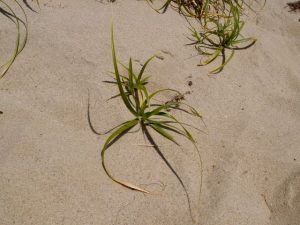By Liz Sheehan |
SANDY HOOK – The American Littoral Society is asking local beachgoers to rid the beaches of an invasive plant which crowds out the native American beachgrass and other plants which protect dunes from eroding.
The grass, Carex kobomugi, or Asiatic sand sedge, originally from Japan, has curly leaves, a long tap root and spreading rhizomes from which new plants grow.
Tim Dillingham, executive director of the society, wants those who see the plant on the beaches to notify the group, but not to pull the plant out.
He said the area from which the plant is removed has to be replanted with American beachgrass or the sedge will spring up again.
American beachgrass, which is long and slender, blocks sand blown off the beach during storms, creating wider and higher dunes. Dillingham said the sedge is much shorter than the beachgrass and therefore doesn’t block the sand, allowing for dune erosion.
He said there are currently no public funds available to aide in the removal of Asiatic sand sedge.

According to Pim Van Hemmen, assistant director of the society, a group of volunteers from the engineering firm T&M Associates, Middletown, recently removed Asiatic sand sedge from the dunes at Sandy Hook. The dunes will be replanted with American beachgrass in the early spring.
Jeff Dement, the chief naturalist for the society, said the American beachgrass had to be planted before March or April so it will be established by the summer.
He said it was unclear where the Asiatic sand sedge first came to the Two River area, but that some was planted in Island Beach State Park years ago.
There has also been speculation it was used as packing material in cargo from Japan, he said, but that was not confirmed.
In addition to being less protective of the dunes than American beachgrass, the sedge also discourages the growth of other plants which serve as habitat and protection for small birds and monarch butterflies. Dillingham said the sedge can block the growth of goldenrod which attracts monarchs to Sandy Hook in the fall during their migration. Goldenrod supplies the butterflies with nectar on their journey to Mexico.
“I think the dunes are the best protection we can build,” Dillingham said, to preserve the beaches.
He said the society was working with local school systems to enlist interest in protecting the dunes, and relying on media coverage to spread the information about the problems with Asiatic sand sedge.
If you notice Asiatic sand sedge at a local beach, contact the American Littoral Society at 732-291-005.
This article was first published in the August 3 – 10, 2017 print edition of The Two River Times.














